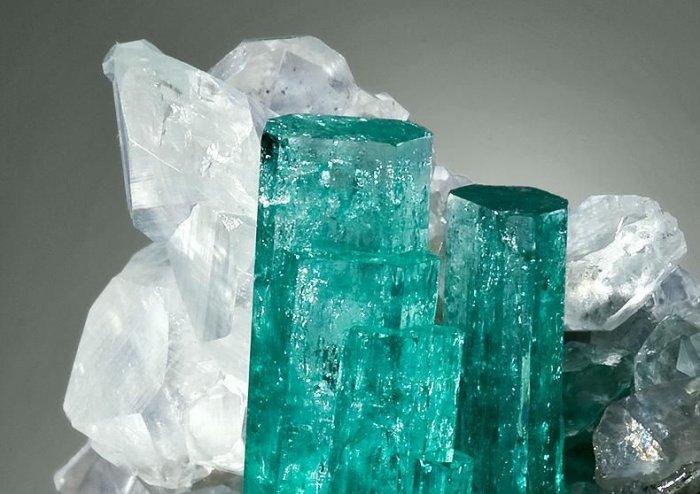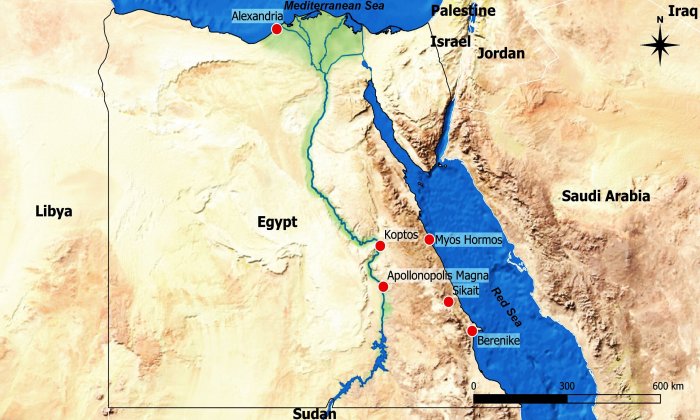Conny Waters – AncientPages.com – Excavations in the Egyptian Eastern Desert delivers proof of emerald mines in Roman Egypt at Wadi Sikait.
For over 5000 years, emeralds have been one of the most desirable and valuable colored stones. Many ancient civilizations in Asia, Africa, and South America independently discovered emeralds and held this gemstone in high esteem.
 Emerald with calcite. Image source
Emerald with calcite. Image source
In the United States and many other countries, emerald serves as the birthstone for people who were born in the month of May.
In their new study, researchers – J. Oller Guzmán, D. Fernández Abella, V. Trevín Pita, O. Achon Casas, and S. García-Dils de la Vega – detail what was found in three buildings in the Mons Smaragdus region in the Egyptian Eastern Desert. The region is known for Roman-era emerald mines, recorded by Pliny the Elder and Claudius Ptolemy, rediscovered in the 19th century by the French mineralogist Fréderic Cailliaud.

Location of Sikait in the Eastern Desert. Image credit: University of Chicago
The “large temple,” one of the most well-preserved structures standing in Sikait, also contained religious artifacts like bones, terracotta body parts, and amulets, and was likely occupied between the fourth and fifth centuries AD, although inner shrines were possibly used earlier, based on surviving traces of Egyptian hieroglyph and other materials.
Finally, the “six windows building” complex, possibly a residential space, included an older inner cavity, which may have been related to mining activity.
However, concerning this type of structure, common in Sikait, the authors write, “After analyzing most of these spaces, we can conclude that almost none of them can be identified as beryl mines, and mainly we are dealing with storage or living spaces.” Nevertheless, the study of the underground structures presents in Sikait and the surrounding areas allowed the documentation of several beryl mining spaces.
The detailed analysis of some mines showed relevant evidence concerning their structure, typology and evolution, including the discovery of the first register inscription ever found in an ancient emerald mine.
 The Large Temple of Sikait seen from the wadi floor. Image credit: University of Chicago
The Large Temple of Sikait seen from the wadi floor. Image credit: University of Chicago
These excavation seasons, the authors write, add to knowledge about emerald production in Roman Egypt. “First, it confirmed the significance of the religious aspect in mining settlements like ancient Senskis.” This shows the importance of the settlement within the emerald mining network, as no other site in which a similar concentration of cult spaces has been recorded.
“This links Sikait to other productive regions in the Eastern Desert, which also offer plentiful evidence of the importance of cult and religion, as the imperial quarries.”
The authors propose this work will provide key evidence in the future for determining how, exactly, the mines were exploited. Future seasons will focus on documenting the mining complexes to get a complete overview of the process of extraction and commercialization of emeralds, which will provide greater historical context.
See also: More Archaeology News
“According to literary sources such as Olympiodorus, in the fifth century AD, a permit from the king of the Blemmyes was required to enter the emerald mines.” Considering that most of the surviving structures in Sikait date to this period, archaeological information from such sites are fundamental for understanding the progressive abandonment of the Roman/Byzantine control in this area and the gradual subsтιтution by the Blemmyan power.
Paper
Written by Conny Waters – AncientPages.com Staff Writer





